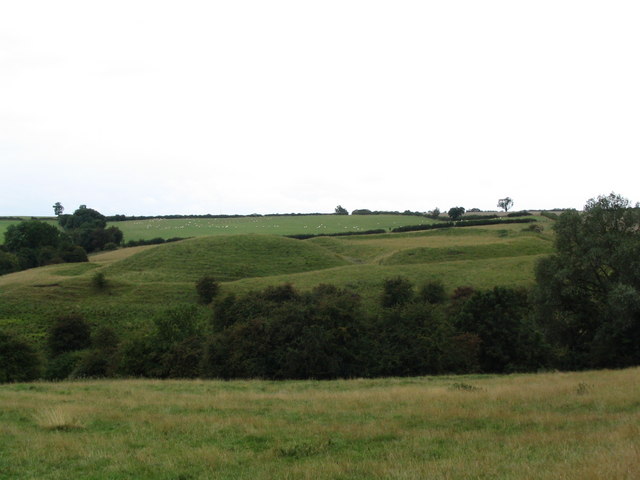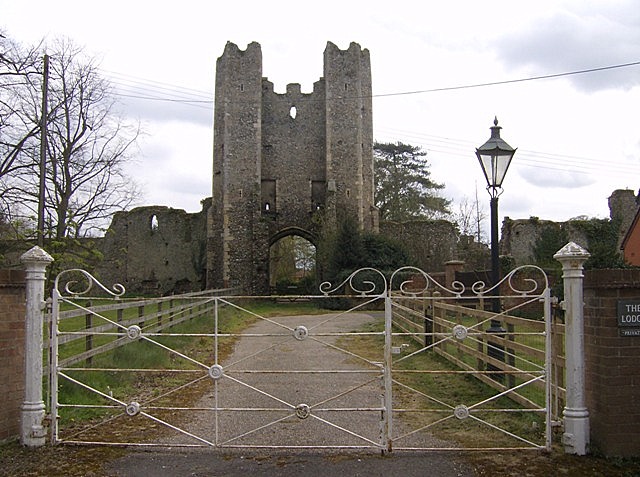|
Mettingham Castle
Mettingham Castle was a fortified manor house in the parish of Mettingham in the north of the English county of Suffolk. Details Mettingham Castle was founded by Sir John de Norwich, who was given a licence to crenellate his existing manor house on the site in 1342.Mackenzie, p.283. The first house stood within a small moat, up to 15 foot wide with 6 foot high banks; upon receiving permission to crenellate, however, he built another court to the north of this, again moated, with a gateway to the north.Wall, p.621. Another moated court was later built to the south. An Edwardian style gatehouse formed the entrance to the castle and supplemented a stone wall that surrounded the property. By 1562, there were "stables, servants' lodgings, kitchen, bakehouse, brewhouse, malting house, storehouses, and an aisled hall" within the castle walls.Mettingham Castle', National Monuments Record, English Heritage, accessed 17 July 2011. The castle remained in Sir John's family until 1394, wh ... [...More Info...] [...Related Items...] OR: [Wikipedia] [Google] [Baidu] |
Mettingham
Mettingham is a village and civil parish in the north of the English county of Suffolk. It is east of the market town of Bungay in the East Suffolk district. It had a population of 211 at the 2011 United Kingdom census. The northern boundary of the parish is formed by the River Waveney which marks the county boundary with Norfolk. The northern section of the parish is within the area of The Broads National Park. The parish borders the parishes of Bungay, Shipmeadow, Ilketshall St John and the Norfolk parishes of Broome and Ellingham. The B1062 Bungay to Beccles road runs through the centre of the parish.Mettingham Healthy Suffolk, 2016. Retrieved 16 February 2021. In the 1870s, Mettingham was described as: : "a village and a parish in |
Norton, Suffolk
Norton is a village and civil parish in the Mid Suffolk district of the English county of Suffolk. The name Norton means northern town or farm.Norton Village website Retrieved 2013-01-31. Located close to the A14, its nearest railway station is at , just over away. The closest towns are away and , around away. History ...[...More Info...] [...Related Items...] OR: [Wikipedia] [Google] [Baidu] |
List Of Castles In England
This list of castles in England is not a list of every building and site that has "castle" as part of its name, nor does it list only buildings that conform to a strict definition of a castle as a medieval fortified residence. It is not a list of every castle ever built in England, many of which have vanished without trace, but is primarily a list of buildings and remains that have survived. In almost every case the buildings that survive are either ruined, or have been altered over the centuries. For several reasons, whether a given site is that of a medieval castle has not been taken to be a sufficient criterion for determining whether or not that site should be included in the list. Castles that have vanished or whose remains are barely visible are not listed, except for some important or well-known buildings and sites. Fortifications from before the medieval period are not listed, nor are architectural follies. In other respects it is difficult to identify clear and cons ... [...More Info...] [...Related Items...] OR: [Wikipedia] [Google] [Baidu] |
Castles In Great Britain And Ireland
Castles have played an important military, economic and social role in Great Britain and Ireland since their introduction following the Norman invasion of England in 1066. Although a small number of castles had been built in England in the 1050s, the Normans began to build motte and bailey and ringwork castles in large numbers to control their newly occupied territories in England and the Welsh Marches. During the 12th century the Normans began to build more castles in stone – with characteristic square keep – that played both military and political roles. Royal castles were used to control key towns and the economically important forests, while baronial castles were used by the Norman lords to control their widespread estates. David I invited Anglo-Norman lords into Scotland in the early 12th century to help him colonise and control areas of his kingdom such as Galloway; the new lords brought castle technologies with them and wooden castles began to be established over ... [...More Info...] [...Related Items...] OR: [Wikipedia] [Google] [Baidu] |
Listed Building
In the United Kingdom, a listed building or listed structure is one that has been placed on one of the four statutory lists maintained by Historic England in England, Historic Environment Scotland in Scotland, in Wales, and the Northern Ireland Environment Agency in Northern Ireland. The term has also been used in the Republic of Ireland, where buildings are protected under the Planning and Development Act 2000. The statutory term in Ireland is " protected structure". A listed building may not be demolished, extended, or altered without special permission from the local planning authority, which typically consults the relevant central government agency, particularly for significant alterations to the more notable listed buildings. In England and Wales, a national amenity society must be notified of any work to a listed building which involves any element of demolition. Exemption from secular listed building control is provided for some buildings in current use for worship, ... [...More Info...] [...Related Items...] OR: [Wikipedia] [Google] [Baidu] |
Scheduled Monument
In the United Kingdom, a scheduled monument is a nationally important archaeological site or historic building, given protection against unauthorised change. The various pieces of legislation that legally protect heritage assets from damage and destruction are grouped under the term "designation." The protection provided to scheduled monuments is given under the Ancient Monuments and Archaeological Areas Act 1979, which is a different law from that used for listed buildings (which fall within the town and country planning system). A heritage asset is a part of the historic environment that is valued because of its historic, archaeological, architectural or artistic interest. Only some of these are judged to be important enough to have extra legal protection through designation. There are about 20,000 scheduled monuments in England representing about 37,000 heritage assets. Of the tens of thousands of scheduled monuments in the UK, most are inconspicuous archaeological sites, but ... [...More Info...] [...Related Items...] OR: [Wikipedia] [Google] [Baidu] |
Mettingham College
Mettingham College was a monastic college in the parish of Mettingham in the English county of Suffolk. The college was located within Mettingham Castle, although it was founded elsewhere. Foundation The college was founded on 24 July 1350, originally as a chantry college for eight secular canons under a master at Raveningham in Norfolk. The founder was Sir John de Norwich, eldest son of Sir Walter de Norwich, Chief Baron of the Exchequer, whose sister Margaret married Robert de Ufford, the future 1st Earl of Suffolk, in 1324. The canons were to celebrate in the parish church of St Andrew, Raveningham, for the welfare of Sir John and his wife, the Blessed Virgin, St Andrew the Apostle, and All Saints. The College itself was dedicated to St Mary. History When writing his will in 1373, another Sir John, grandson of the founder, was planning to move the college to Norton Subcourse, and left £450 for the building of a new church there. However this plan foundered. His cousin K ... [...More Info...] [...Related Items...] OR: [Wikipedia] [Google] [Baidu] |
Secular Canon
A canon (from the Latin , itself derived from the Greek , , "relating to a rule", "regular") is a member of certain bodies in subject to an ecclesiastical rule. Originally, a canon was a cleric living with others in a clergy house or, later, in one of the houses within the precinct of or close to a cathedral or other major church and conducting his life according to the customary discipline or rules of the church. This way of life grew common (and is first documented) in the 8th century AD. In the 11th century, some churches required clergy thus living together to adopt the rule first proposed by Saint Augustine that they renounce private wealth. Those who embraced this change were known as Augustinians or Canons Regular, whilst those who did not were known as secular canons. Secular canons Latin Church In the Latin Church, the members of the chapter of a cathedral (cathedral chapter) or of a collegiate church (so-called after their chapter) are canons. Depending on the ... [...More Info...] [...Related Items...] OR: [Wikipedia] [Google] [Baidu] |
Suffolk
Suffolk () is a ceremonial county of England in East Anglia. It borders Norfolk to the north, Cambridgeshire to the west and Essex to the south; the North Sea lies to the east. The county town is Ipswich; other important towns include Lowestoft, Bury St Edmunds, Newmarket, and Felixstowe which has one of the largest container ports in Europe. The county is low-lying but can be quite hilly, especially towards the west. It is also known for its extensive farming and has largely arable land with the wetlands of the Broads in the north. The Suffolk Coast & Heaths and Dedham Vale are both nationally designated Areas of Outstanding Natural Beauty. History Administration The Anglo-Saxon settlement of Suffolk, and East Anglia generally, occurred on a large scale, possibly following a period of depopulation by the previous inhabitants, the Romanised descendants of the Iceni. By the fifth century, they had established control of the region. The Anglo-Saxon inhabitants later b ... [...More Info...] [...Related Items...] OR: [Wikipedia] [Google] [Baidu] |
Mettingham Castle Plan
Mettingham is a village and civil parish in the north of the English county of Suffolk. It is east of the market town of Bungay in the East Suffolk district. It had a population of 211 at the 2011 United Kingdom census. The northern boundary of the parish is formed by the River Waveney which marks the county boundary with Norfolk. The northern section of the parish is within the area of The Broads National Park. The parish borders the parishes of Bungay, Shipmeadow, Ilketshall St John and the Norfolk parishes of Broome and Ellingham. The B1062 Bungay to Beccles road runs through the centre of the parish.Mettingham Healthy Suffolk, 2016. Retrieved 16 February 2021. In the 1870s, Mettingham was described as: : "a village and a parish in |
English Heritage
English Heritage (officially the English Heritage Trust) is a charity that manages over 400 historic monuments, buildings and places. These include prehistoric sites, medieval castles, Roman forts and country houses. The charity states that it uses these properties to "bring the story of England to life for over 10 million people each year". Within its portfolio are Stonehenge, Dover Castle, Tintagel Castle and the best preserved parts of Hadrian's Wall. English Heritage also manages the London Blue Plaque scheme, which links influential historical figures to particular buildings. When originally formed in 1983, English Heritage was the operating name of an executive non-departmental public body of the British Government, officially titled the Historic Buildings and Monuments Commission for England, that ran the national system of heritage protection and managed a range of historic properties. It was created to combine the roles of existing bodies that had emerged from a long ... [...More Info...] [...Related Items...] OR: [Wikipedia] [Google] [Baidu] |








.jpg)